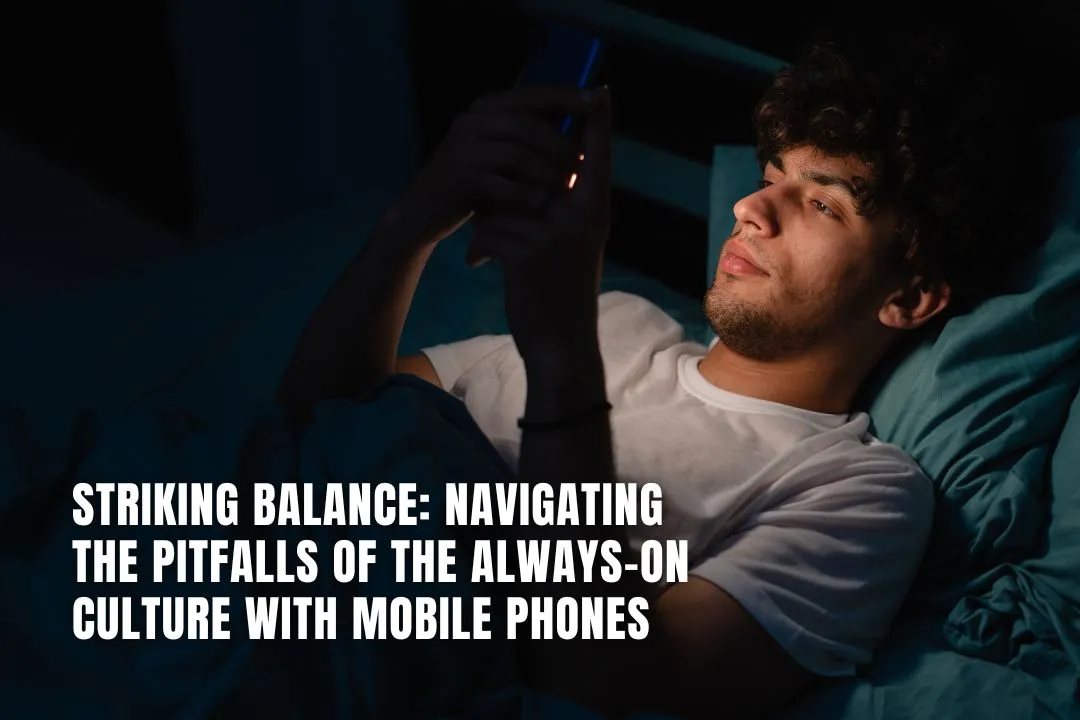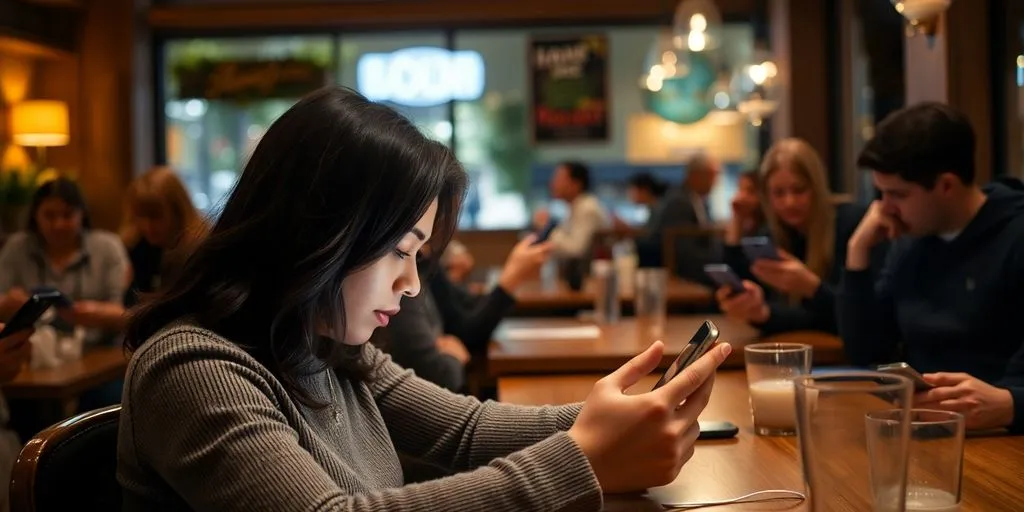Striking Balance: Navigating the Pitfalls of the Always-On Culture with Mobile Phones
October 2, 2024

Mobile phones have transformed the way we communicate and interact. As these devices have become a part of our daily lives, we've entered an era where being constantly connected is the norm. This shift, while convenient, has also led to challenges that affect our work-life balance, mental health, and social interactions. Understanding the implications of this always-on culture is essential for finding a healthy balance in our lives.
Key Takeaways on the Pitfalls of the Always-On Culture
- Transformation of Communication: The shift from landlines to mobile phones has fundamentally changed how we communicate, leading to an always-on culture where quick responses are expected.
- Challenges of Constant Connectivity: The always-on culture has blurred boundaries between work and personal life, resulting in increased stress, difficulty focusing on personal interests, and strained relationships.
- Impact on Mental Health: Constant connectivity has been linked to heightened anxiety, burnout, and decreased sleep quality due to late-night notifications.
- Workplace Dynamics: Mobile phones have transformed workplace expectations, with employees often expected to respond immediately, creating stress and impacting work-life balance.
- Social Implications: Mobile phone usage has altered social etiquette, leading to distracted interactions, reduced empathy in conversations, and a rise in digital addiction.
- Safety Concerns: The use of mobile phones poses significant safety risks, including distracted driving and health issues associated with prolonged screen time, such as eye strain and poor posture.
- Strategies for Management: Establishing boundaries, promoting digital detox, and encouraging mindful usage are essential strategies for managing mobile phone culture and improving overall well-being.
- Future Trends: Advancements in technology, evolving social norms, and potential workplace policies will shape the future of mobile phone culture, necessitating a balance between connectivity and personal well-being.
Register Your LLC
Company Registration
START NOWThe Evolution of Mobile Phone Culture
From Landlines to Mobile Phones
The journey from landlines to mobile phones has transformed how we connect. Mobile phones have become essential in our daily lives, allowing us to communicate anytime, anywhere. This shift has made it common for people to prefer texting or calling on their mobile devices rather than using traditional landlines.
The Shift in Communication Norms
As mobile phones gained popularity, communication norms changed significantly. Now, it’s expected that:
- People will respond quickly to messages.
- Calls can happen in any setting, even during meals.
- Social interactions often occur through screens rather than face-to-face.
The Role of Mobile Phones in Modern Society
Today, mobile phones are more than just communication tools; they are:
- Access points to information and services.
- Platforms for social media and entertainment.
- Essential for work and personal organization.
Mobile phones have reshaped our culture, making us more connected yet often overwhelmed by the constant flow of information.
In summary, the evolution of mobile phone culture reflects a significant change in how we communicate and interact with the world around us. The convenience of being always connected comes with its own set of challenges, which we must navigate carefully.
Challenges of the Always-On Culture
Blurring Boundaries Between Work and Personal Life
The always-on culture makes it hard to separate work from personal time. Many people find it difficult to switch off after work hours. This can lead to:
- Increased stress levels
- Decreased family time
- Difficulty in focusing on personal interests
The Pressure of Constant Availability
With mobile phones, there’s an expectation to be available at all times. This pressure can create:
- Anxiety about missing messages or calls
- A feeling of being overwhelmed
- Strain on personal relationships
Impact on Mental Health and Well-being
The constant connectivity can take a toll on mental health. Studies show that:
- People feel more stressed and anxious
- There’s a rise in burnout cases
- Sleep quality often decreases due to late-night notifications
In today’s world, it’s essential to find a balance between being connected and taking time for oneself.
By understanding these challenges, individuals can take steps to manage their mobile phone usage better and protect their well-being.
Mobile Phones and Workplace Dynamics
Expectations of Immediate Responses
In today's work environment, the expectation for immediate responses has grown significantly. Employees are often expected to reply to messages and emails almost instantly, regardless of their location. This can lead to:
- Increased stress levels
- Difficulty in focusing on tasks
- A blurred line between work and personal time
Balancing Professional and Personal Communication
Finding a balance between work and personal communication is crucial. Here are some strategies:
- Set specific times for checking work emails.
- Use separate apps for work and personal messages.
- Communicate boundaries with colleagues and supervisors.
Employer and Employee Boundaries
Establishing clear boundaries is essential for a healthy work-life balance. Both employers and employees should:
- Discuss availability expectations openly.
- Respect personal time and space.
- Understand the importance of disconnecting after work hours.
Maintaining a healthy balance between work and personal life is vital for overall well-being. The key is to communicate openly and set clear boundaries.
In summary, mobile phones have transformed workplace dynamics, creating both opportunities and challenges. By understanding these dynamics, we can better navigate the complexities of modern work life, ensuring that we maintain our personal connections while meeting professional expectations.
Highlights:
- Immediate responses
- Balancing technology and personal connections in modern business
- Balancing remote and in-office work: best practices
Social Implications of Mobile Phone Usage
Changing Social Etiquette
The rise of mobile phones has transformed how we interact in public. People now often engage in phone conversations in social settings, which can disrupt the flow of face-to-face interactions. Here are some key points about changing social norms:
- Public conversations are more common, leading to mixed reactions.
- Many people feel it’s acceptable to answer calls in restaurants or during events.
- The expectation of constant availability can create discomfort in social situations.
Impact on Face-to-Face Interactions
Mobile phones can sometimes hinder real-life conversations. The presence of a phone can lead to:
- Distraction during discussions, as people may check notifications.
- A feeling of disconnection, even when physically present with others.
- Reduced empathy, as attention shifts to the screen rather than the person.
The Rise of Digital Addiction
As mobile phones become integral to daily life, many individuals face challenges with overuse. This can lead to:
- Neglecting personal relationships in favor of online interactions.
- Increased anxiety when separated from devices, known as "nomophobia."
- Difficulty in focusing on tasks due to constant notifications.
In our always-connected world, it’s crucial to find a balance between digital engagement and real-life interactions.
In summary, while mobile phones offer convenience, they also reshape our social landscape, often leading to challenges in communication and connection.
Safety Concerns in the Mobile Phone Era

Distracted Driving
Using mobile phones while driving is a major safety issue. Many accidents happen because drivers are distracted by their phones. A survey found that 38% of Americans have been hit or nearly hit by a driver who was distracted. Here are some key points:
- 1 in 4 Americans use apps like GPS while driving.
- Distracted driving is a factor in 25% of police-reported crashes.
- Brain activity related to driving decreases by 37% when using a phone.
Health Risks Associated with Prolonged Use
Spending too much time on mobile phones can lead to health problems. Some common issues include:
- Eye strain from staring at screens.
- Poor posture leading to back and neck pain.
- Sleep problems due to blue light exposure.
Cybersecurity Threats
As we use mobile phones more, we also face more risks online. Cybersecurity threats can include:
- Hacking of personal information.
- Phishing scams targeting mobile users.
- Malware that can steal data or damage devices.
Mobile phones are essential, but we must be aware of the risks they bring. Taking steps to stay safe is crucial for our well-being.
In conclusion, while mobile phones offer many benefits, they also come with significant safety concerns that we must address to protect ourselves and others.
Strategies for Managing Mobile Phone Culture
Setting Boundaries and Limits
To effectively manage mobile phone usage, it’s essential to establish clear boundaries. Here are some strategies:
- Designate phone-free times: Set specific hours during which phones are not used, such as during meals or family time.
- Create phone-free zones: Identify areas in your home or workplace where phone usage is not allowed.
- Use apps to limit usage: Consider using applications that track and limit your screen time.
Promoting Digital Detox
Taking breaks from mobile devices can greatly improve mental health. Here are some ideas for a digital detox:
- Schedule regular breaks: Plan daily or weekly periods where you completely disconnect from your phone.
- Engage in offline activities: Find hobbies or activities that don’t involve screens, like reading or outdoor sports.
- Encourage group detoxes: Invite friends or family to join you in a digital detox challenge.
Encouraging Mindful Usage
Being mindful about how and when we use our phones can lead to healthier habits. Consider these tips:
- Reflect on your usage: Take time to think about how often you check your phone and why.
- Limit notifications: Turn off non-essential notifications to reduce distractions.
- Practice gratitude: Focus on the positive aspects of life without your phone, such as enjoying nature or spending time with loved ones.
Managing mobile phone culture is crucial for maintaining a healthy balance in our lives. By setting boundaries, promoting detoxes, and encouraging mindful usage, we can navigate the challenges of an always-on world effectively.
These strategies can help individuals reclaim their time and improve their overall well-being while still enjoying the benefits of mobile technology.
Highlighted Points
- Designate phone-free times
- Schedule regular breaks
- Reflect on your usage
Future Trends in Mobile Phone Culture

Technological Advancements
The future of mobile phones is bright, with new technologies emerging every year. Innovations like foldable screens and enhanced battery life are just the beginning. Here are some expected advancements:
- 5G Connectivity: Faster internet speeds will change how we use our phones.
- AI Integration: Smarter assistants will help us manage our daily tasks.
- Sustainable Materials: Phones made from eco-friendly materials will become more common.
Evolving Social Norms
As mobile phones become more integrated into our lives, social norms will continue to shift. People will likely:
- Expect more privacy in public spaces.
- Develop new etiquette for phone usage during gatherings.
- Embrace technology-free zones to promote face-to-face interactions.
Potential Solutions to Current Challenges
To tackle the issues of the always-on culture, we might see:
- Workplace Policies: Companies may implement rules to limit after-hours communication.
- Mindfulness Apps: Tools that encourage users to take breaks from their devices.
- Community Initiatives: Programs promoting digital detoxes and healthy phone habits.
The future of mobile phone culture will require us to adapt and find a balance between connectivity and personal well-being. The rise of digital addiction is a concern that needs addressing as we move forward.
In conclusion, as we look ahead, the mobile phone landscape will continue to evolve, shaping our communication and social interactions in ways we are just beginning to understand.
Conclusion
In summary, the always-on culture shaped by mobile phones has changed how we communicate and interact. While these devices offer convenience and keep us connected, they also blur the lines between work and personal life. People feel pressured to respond to messages and calls at all times, which can lead to stress and burnout. It's important for everyone to set clear boundaries to protect their personal time. By finding a balance, we can enjoy the benefits of technology without letting it take over our lives.
Frequently Asked Questions
What is the always-on culture?
The always-on culture means that people feel they should always be available and connected, especially through their mobile phones.
How have mobile phones changed communication?
Mobile phones have made it easier to talk to anyone at any time, making communication faster and more constant.
What are some problems with being always connected?
Being always connected can blur the lines between work and personal life, leading to stress and less time for relaxation.
How can I set boundaries with my phone?
You can set boundaries by turning off notifications during certain times, like family dinners or while studying.
What is digital detox?
Digital detox is when you take a break from your devices to reduce stress and improve your well-being.
What are the risks of using phones while driving?
Using phones while driving can distract you and increase the chances of accidents.

